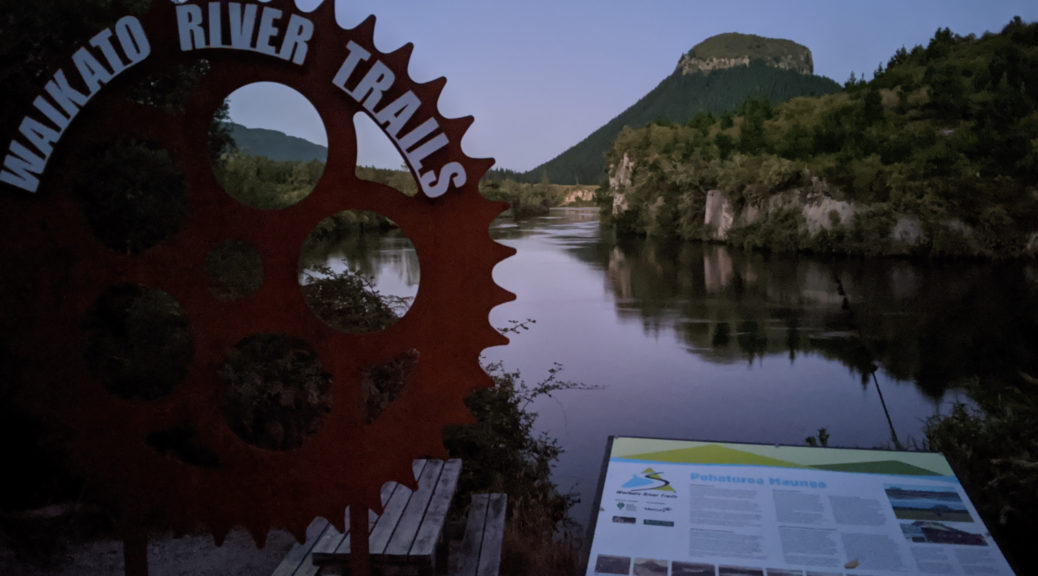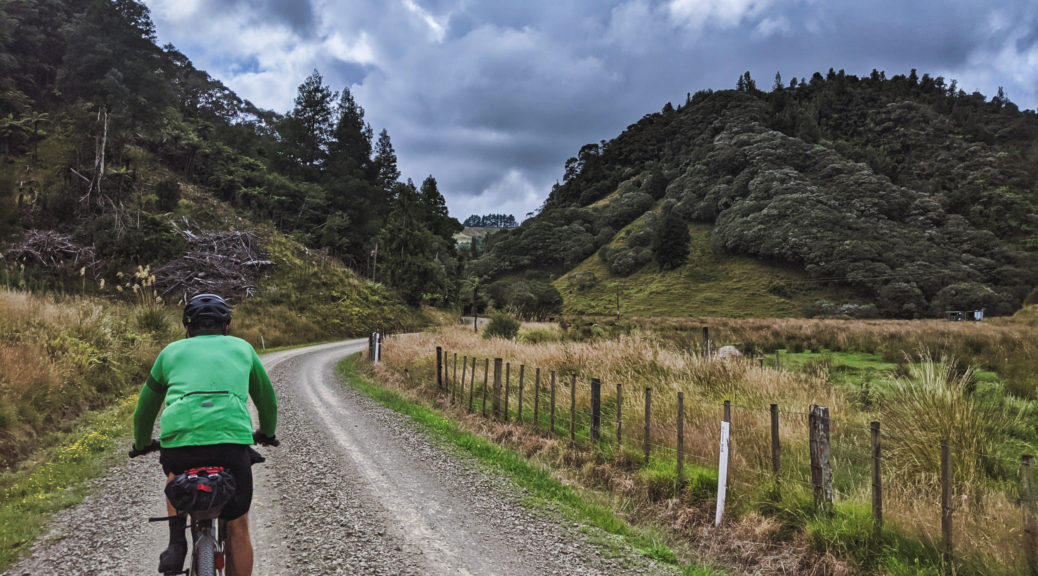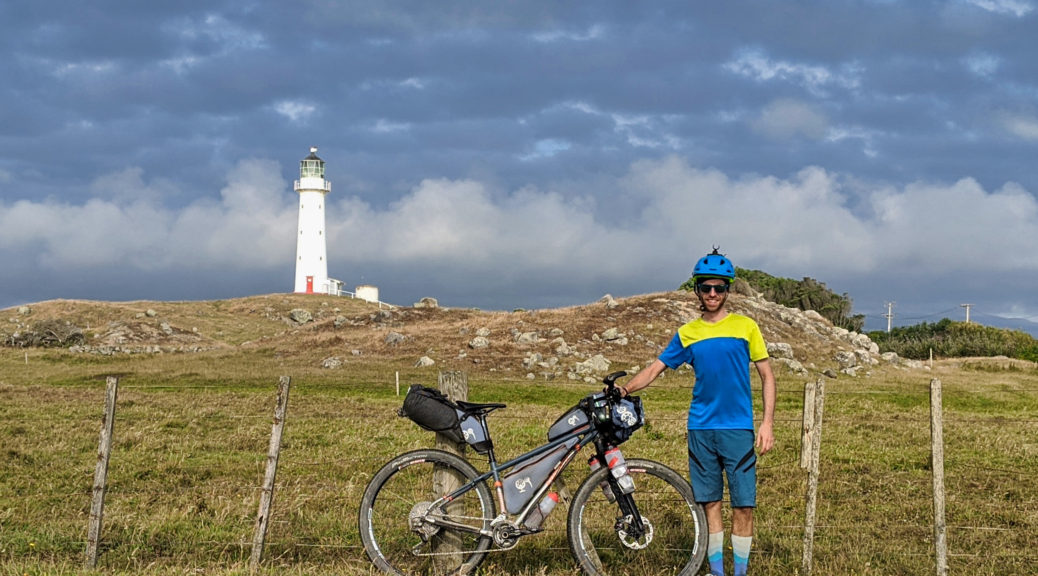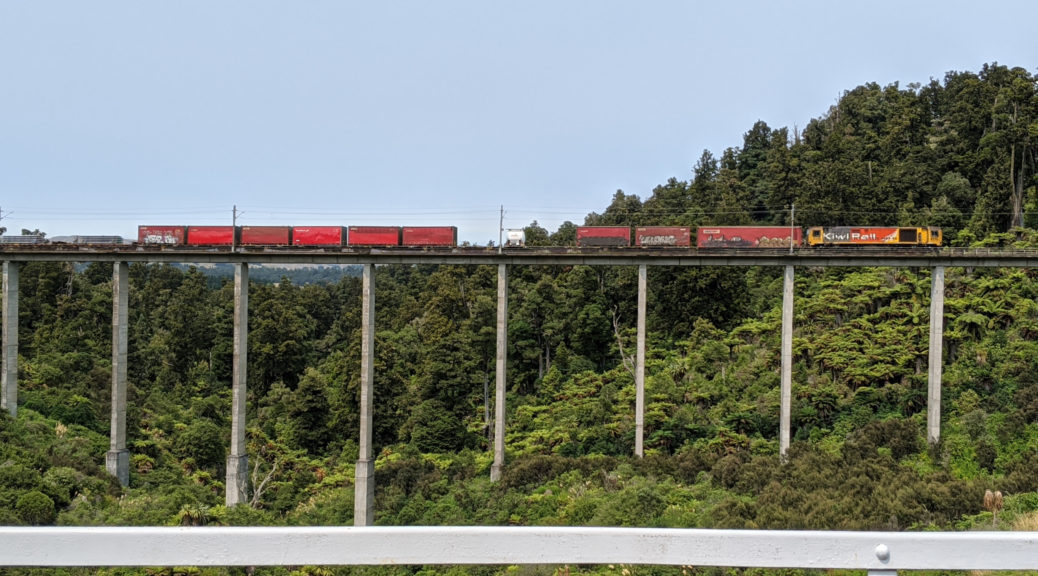A leisurely start to the day with twenty-five kilometres of quiet backroads, with only the slightest of inclines as we followed the Ongarue River upstream and turned off to begin the Timber Trail.
 There’s that railway again, for the last time on this trip.
There’s that railway again, for the last time on this trip.
Both Pete and I were looking forward to riding the Timber Trail in the reverse, south to north, direction to that which is normal. With a gentle southerly behind us, it didn’t disappoint. One of the reasons I prefer riding it in this direction is that the part of the trail that is in the worst condition (up to the Ongarue Spiral) is over and done with straightaway and one can forget about how poorly maintained and uninspiring that section is; going the other direction, it’s such a disappointment to finish an otherwise great day on.
Suspension bridges galore still delight – such vast gaps in terrain they bridge, with the native bush-clad valleys so far below. With both of us having ridden this trail plenty of times, photos are few and far between. One of the highlights was stopping in and checking out the new Camp Epic – and not just because the kettle was on and we got tea and coffee. All the tents spread around the big clearing and campfire, over a dozen, form part of quite the facility (cooking shelter, toilet and shower block, and plenty of room to pitch your own tent) – a worthy addition to the limited facilities on the trail. As always, maybe one day I’ll ride the trail more slowly and, therefore, get to stay here. I commented that the tents, not so much the surroundings, reminded me of being on safari – turns out all the tents were imported from South Africa, so that explains that.



Trail traffic increased later in the afternoon, as we came across a few bikepackers and many that were riding the trail over two days – either stopping at the lodge or Camp Epic. The views from the high point on Pureora over to Lake Taupo were some of the clearest we’ve both seen – often it’s either dark or clagged in when I’ve been up there. From there, the chief reason that I prefer the direction we were heading – a stonking great ten kilometre downhill to finish. Riding the last few kilometres, after it’s flattened out a bit, through pristine native bush, having to pedal a bit but able to hold a lot of speed, is my favourite piece of semi-technical mountain-biking on the trail; such fun to finish.
While that was a lot of the day’s climbing done, it was far warmer down a few hundred metres lower and out from underneath the canopy. As Pete educated me a bit more about the timing of when this forest was saved from logging and when various hiking trails were formed and huts built, we climbed up to the amusing “Centre of the North Island” (a piece of cardboard!). The notorious Arataki Swing Bridge had passed its load test a day or two before, so we didn’t have to take a large detour. Instead it was back past the place where I was overcome with heat stroke symptoms three months before, I’m unsure how I’d managed to climb up and get to Pureora – it sure was a long downhill to get to the spot.
Surviving the bridge, I only managed to jam my thumb between my handlebars and an upright once, there was a little pushing up to the road end before a quick sealed, descent to Whakamaru for fish, burgers, milkshakes, ice cream and resupply. While it hadn’t been a big day for distance, such a long trail can take it out of you. We planned to ride what I consider to be one of the easiest and most pleasant sections of the Waikato River Trails for twenty-five kilometres to a short stretch on State Highway One before finding somewhere to bivy overnight.
A glorious evening, the mighty Waikato was becalmed. Although I’d only ridden this section once, and enjoyed it so, and knew there was little elevation gain to be had – I’d long ago learnt that one underestimates this collection of trails at your own peril, especially on a loaded bike at the end of a long day. So it was, the tiny pinch climbs kept coming – hitting us one after the other for much of the first half of the section. But it was such a stunning evening, it could hardly have gotten to us. Things flattened out around some fields and we could hold some speed, eventually popping out on the highway a little after nine o’clock.
 The end of the trail would come close to Pohaturoa, which was just over the river from the trailhead.
The end of the trail would come close to Pohaturoa, which was just over the river from the trailhead.
With Waitangi Day the following day, a Thursday, I was expecting the highway to be busy with traffic heading south from Auckland for a four-day weekend. It really wasn’t that bad, the four kilometres having ample shoulder. Ten more minutes and we’d dropped down to the river, crossed the Ohakuri Dam and found a very quiet and sheltered spot to camp the night. A shorter day for distance, there was much riding in that 173 km – over a hundred of them were trail; another pleasing day, we figured we’d completed the difficult half of our North Island Traverse and were well on schedule to finish within four days.


 The day promised to be cloudier than the previous few.
The day promised to be cloudier than the previous few. No views through the bridge of Taranaki today.
No views through the bridge of Taranaki today. Cruising up a two hundred metre climb; flowering kanuka was also a feature of the day.
Cruising up a two hundred metre climb; flowering kanuka was also a feature of the day. 
 Climbing Moki Rd, heading for the second tunnel of the day.
Climbing Moki Rd, heading for the second tunnel of the day. Tunnel number two for the day.
Tunnel number two for the day. A good sign as we head up Kiwi Rd; we saw little traffic, as had been the case since Urenui.
A good sign as we head up Kiwi Rd; we saw little traffic, as had been the case since Urenui. Tunnel #3.
Tunnel #3. Duck!
Duck!

 Hobbit Hole, the sign says; the tunnel on the FWH.
Hobbit Hole, the sign says; the tunnel on the FWH. Approaching Tahora Saddle – rails stay low.
Approaching Tahora Saddle – rails stay low. The hotel wasn’t really open at nine-thirty, but they rustled up bacon and eggs for me nonetheless – supreme.
The hotel wasn’t really open at nine-thirty, but they rustled up bacon and eggs for me nonetheless – supreme. I rode through the tunnel doing my best impression of a logging truck…
I rode through the tunnel doing my best impression of a logging truck…  …and got this photo for my efforts.
…and got this photo for my efforts. Sometimes you get to see Taranaki.
Sometimes you get to see Taranaki.
 The Tasman Sea tantalisingly close and less traffic once I was off the route between towns.
The Tasman Sea tantalisingly close and less traffic once I was off the route between towns. So, that’s the heading-west side of the trip done.
So, that’s the heading-west side of the trip done.

 Heading out of town, the road briefly followed the tracks – but they soon headed north as I went west.
Heading out of town, the road briefly followed the tracks – but they soon headed north as I went west. Turning north, I was heading straight for Ruapehu – it far closer than the previous day.
Turning north, I was heading straight for Ruapehu – it far closer than the previous day. A more recent, straighter, viaduct built to cater for increased speed of new trains.
A more recent, straighter, viaduct built to cater for increased speed of new trains. The old viaduct had been restored to allow human-powered passage.
The old viaduct had been restored to allow human-powered passage.
 I was surprised at just how short the trains were; I expect, and hope, there’s some technical reason for that.
I was surprised at just how short the trains were; I expect, and hope, there’s some technical reason for that. The riding was most pleasant too, the green cover keeping the heat away.
The riding was most pleasant too, the green cover keeping the heat away. Another closed viaduct.
Another closed viaduct. This sign gets the day’s “bleedingly obvious” prize.
This sign gets the day’s “bleedingly obvious” prize. Another Ruapehu shot, this time with decaying transport relics.
Another Ruapehu shot, this time with decaying transport relics. One of the more well known of such establishments in NZ, it’s been used as a location for quintessential Kiwi films such as
One of the more well known of such establishments in NZ, it’s been used as a location for quintessential Kiwi films such as  For a change, Ngauruhoe
For a change, Ngauruhoe
 Seems legit.
Seems legit. Farming around here didn’t look particularly profitable.
Farming around here didn’t look particularly profitable. First I paused at the Kaitieke war memorial.
First I paused at the Kaitieke war memorial.